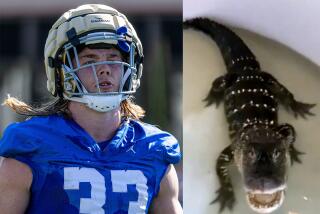Ropes, Syringes, Tape : Genteel Hunters Catch Crocs Alive
- Share via
GARSEN, Kenya — A genteel Crocodile Dundee has arrived in the shadows of Mt. Kilimanjaro--a big-time hunter who takes the slithering killer reptiles alive.
Kobi Kagan, an Israeli-born crocodile hunter, says he is helping save man’s last link with dinosaurs by snaring them and breeding them on a farm near the Indian Ocean port of Mombasa.
While replenishing the once-threatened crocodile supply, Kagan is also making a killing himself from the skins and meat his farm produces.
In April, a Paris furrier bought 150 skins for $250,000 and Kagan has plans to sell the rest of his quota--650 skins--later this year. The meat, which tastes like a cross between fish and chicken, is sold to a Nairobi restaurant. And Kagan’s farm also exports 1,000 newly born crocs to other breeding centers at $20 each.
Single Most Dangerous Animal
Local villagers like the farming idea--the crocodile is the single most dangerous animal in Kenya. Newspapers reported 180 attacks on humans last year but the actual total of croc attacks was probably much higher.
“Villagers use the river for washing, drinking and swimming, and many of them end up being eaten by a crocodile,” Kagan said. “So of course they hate crocs and see us as kind of gods for capturing them.”
The local Pokomo tribesmen “eat or destroy the eggs, kill the crocodiles whenever they can,” Kagan says. The tribesmen think eating the reptile’s genitals will increase their virility.
The trade in crocodile skins is strictly regulated by the Convention on International Trade in Endangered Species of Wild Flora and Fauna, which has 90 signatories, including Kenya. But environmentalists believe crocodile farming is one of the safest methods of conserving a near-perfect species that 150 million years ago shared the Earth with dinosaurs and other now-extinct reptiles.
The hunters operate along the murky Tana river near the sleepy town of Garsen, in southeastern Kenya. Their gear bears little resemblance to the arsenals that Ernest Hemingway described hunters carrying in “The Snows of Kilimanjaro.” Killing big game has been outlawed for a decade in Kenya’s famed hunting grounds.
These hunters use ropes, syringes and adhesive tape.
But Kagan still sometimes sounds a bit like a Aussie macho movie hero himself. Capturing the man-eaters, he says, “is fairly easy and safe if you know how to.”
On a good night, his team will catch 10 to 20 Nile crocodiles weighing up to 300 pounds. They blind them with a spotlight, slip a noose around their jaws, inject them with a muscle-relaxing drug and haul them into a small motorboat.
As soon as a reptile is pulled into the boat, the hunters tape its eyelids shut, which reduces its heartbeat by half and makes it docile. As an extra precaution, the hunters wrap their catch in canvas sacking to prevent its powerful armored tail, the beast’s chief weapon, from thrashing around.
From Garsen, the crocs are taken 130 miles to Kagan’s Mombasa breeding farm, known as Mamba (Swahili for crocodile) Village, which doubles as a tourist attraction.
Kagan says he has 6,500 crocs, most of them 3- to 6-month-old hatchlings, and hopes to increase the number to 20,000.
At Mamba Village, females lay 20 to 80 eggs once a year, as they do in the wild. But Kagan says the crocs, which can live to age 100, enjoy a much higher survival rate at the farm, where they have no enemies.
Two months after the eggs are laid, farm workers delicately unearth them and place them in cardboard boxes in layers separated by sand, exactly the pattern used by the mother. About 10 days later, a soft croaking sound rises from the eggs, a signal for workers to unpack them. The hatchlings are put in tanks half filled with water. In the wild, crocodile mothers carry their babies to the water in their mouths.
“The main thing is to control the diet and regulate the temperature of the tanks and the water,” Kagan says.
Coldblooded, the body temperature of a crocodile is determined by its environment. On a hot day, a croc opens its mouth and uses its extended tongue as a thermostat. The wind blows across it and cools off the rest of the armored body.
Crocodiles have an astonishing control of their metabolism and can reduce their heartbeat from 40 to 10 beats a minute to stay immersed for up to eight ours. While it is under water, it closes off the supply of blood and oxygen to its legs and tail, saving it for the essential organs.
‘Usually Swallow Stones’
Kagan is reluctant to reveal what his crocs feed on except that “they usually swallow stones. It helps them grind the chunks of meat they swallow whole.”
Crocodiles cannot chew. They slide up to a river bank, knock down unsuspecting prey with a powerful and quick sweep of their tails, and drag it into the water. They shake their victims violently, ripping off chunks of flesh.
“A horrible death,” says Kagan, who is nonetheless convinced that “crocs are not terribly vicious.
“They only attack to protect their territory, their females, or if they are hungry. (They’re) very reasonable, really.”
Especially after they are asleep, he might have added.
More to Read
Sign up for Essential California
The most important California stories and recommendations in your inbox every morning.
You may occasionally receive promotional content from the Los Angeles Times.













